Panamic Sergeant Major, Abudefduf troschelii
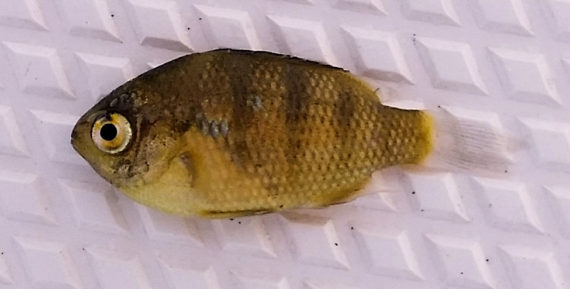 Panamic Sergeant Major, Abudefduf troschelii, Juvenile. Fish collected with a bait net off the surface in coastal waters off Loreto, Baja California Sur, June 2017. Length: 3.8 cm (1.5 inches).
Panamic Sergeant Major, Abudefduf troschelii, Juvenile. Fish collected with a bait net off the surface in coastal waters off Loreto, Baja California Sur, June 2017. Length: 3.8 cm (1.5 inches).
 Panamic Sergeant Major, Abudefduf troschelii. Fish caught from within the Old Marina, Puerto Peñasco, Sonora, November 2020. Length: 13.8 cm (5.4 inches). Catch, photograph and identification courtesy of Chris Moore, Peoria, Arizona.
Panamic Sergeant Major, Abudefduf troschelii. Fish caught from within the Old Marina, Puerto Peñasco, Sonora, November 2020. Length: 13.8 cm (5.4 inches). Catch, photograph and identification courtesy of Chris Moore, Peoria, Arizona.
 Panamic Sergeant Major, Abudefduf troschelii, Breeding Male. Fish caught from shore at Km 21, Cabo Real, Baja California Sur, March 2018. Length: 18.2 cm (7.2 inches).
Panamic Sergeant Major, Abudefduf troschelii, Breeding Male. Fish caught from shore at Km 21, Cabo Real, Baja California Sur, March 2018. Length: 18.2 cm (7.2 inches).
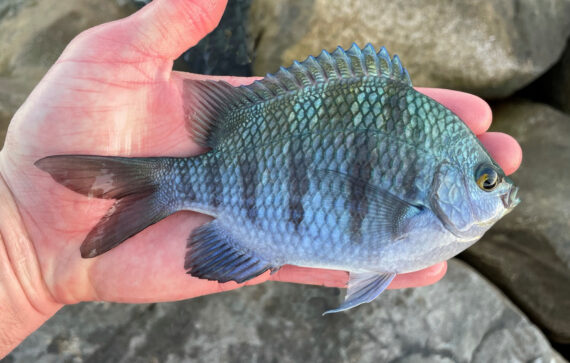 Panamic Sergeant Major, Abudefduf troschelii, Breeding Male. Fish caught from coastal waters off Puerto Peñasco, Sonora, November 2020. Length: 16 cm (6.3 inches). Catch, photograph and identification courtesy of Luke Ovgard, Klamath Falls, Oregon.
Panamic Sergeant Major, Abudefduf troschelii, Breeding Male. Fish caught from coastal waters off Puerto Peñasco, Sonora, November 2020. Length: 16 cm (6.3 inches). Catch, photograph and identification courtesy of Luke Ovgard, Klamath Falls, Oregon.
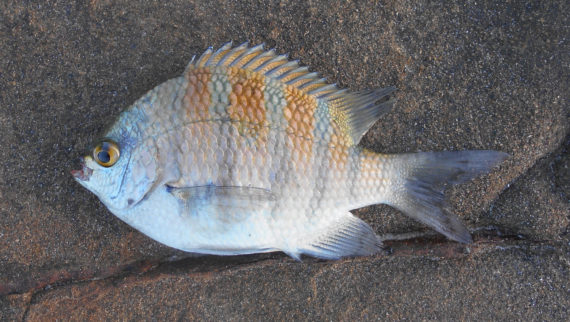 Panamic Sergeant Major, Abudefduf troschelii. Fish caught from shore at La Bocana, Baja California Sur, April 2016. Length 18.5 cm (7.3 inches). Note the atypical bronze coloration.
Panamic Sergeant Major, Abudefduf troschelii. Fish caught from shore at La Bocana, Baja California Sur, April 2016. Length 18.5 cm (7.3 inches). Note the atypical bronze coloration.
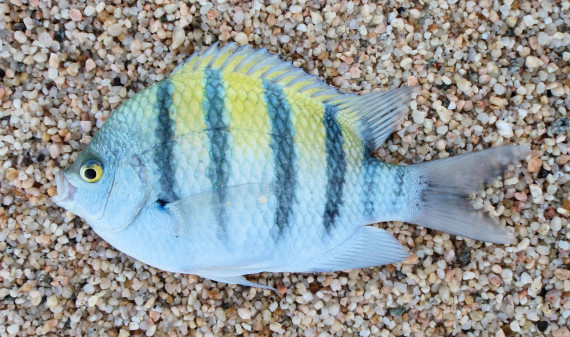 Panamic Sergeant Major, Abudefduf troschelii, Female or Non-breeding Male. Fish caught from shore at Km 21, Cabo Real, Baja California Sur, December 2001. Length: 19.7 cm (7.8 inches).
Panamic Sergeant Major, Abudefduf troschelii, Female or Non-breeding Male. Fish caught from shore at Km 21, Cabo Real, Baja California Sur, December 2001. Length: 19.7 cm (7.8 inches).
 Panamic Sergeant Major, Abudefduf troschelii, Female or Non-breeding Male. Fish caught from shore in Mazatlán, Sinaloa, April 2015. Length: 20 cm (7.9 inches). Catch, photograph, and identification courtesy of Josh Leisen (joshadventures.com), Gaylord, Michigan.
Panamic Sergeant Major, Abudefduf troschelii, Female or Non-breeding Male. Fish caught from shore in Mazatlán, Sinaloa, April 2015. Length: 20 cm (7.9 inches). Catch, photograph, and identification courtesy of Josh Leisen (joshadventures.com), Gaylord, Michigan.
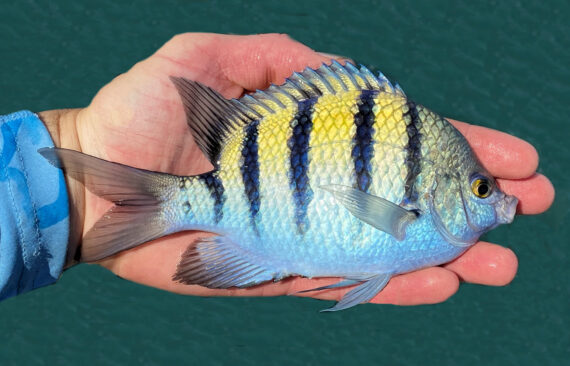 Panamic Sergeant Major, Abudefduf troschelii, Female or Non-breeding Male. Fish caught from coastal waters off Puerto Peñasco, Sonora, November 2020. Length: 21 cm (8.3 inches). Catch, photograph and identification courtesy of Luke Ovgard, Klamath Falls, Oregon.
Panamic Sergeant Major, Abudefduf troschelii, Female or Non-breeding Male. Fish caught from coastal waters off Puerto Peñasco, Sonora, November 2020. Length: 21 cm (8.3 inches). Catch, photograph and identification courtesy of Luke Ovgard, Klamath Falls, Oregon.
The Panamic Sergeant Major, Abudefduf troschelii, is a member of the Damselfish or Pomacentridae Family, and is known in Mexico as petaca banderita. Globally, there are twenty-five species in the genus Abudefduf, of which four are found in Mexican waters, two in the Atlantic Ocean and two in the Pacific Ocean.
The Panamic Sergeant Major has a relatively deep oblong compressed body with a depth of 54% to 58% of standard length, thus similar in nature to freshwater bluegills. They are whitish to pale silvery green in color with a bright yellow back and dark bars across the side of their body and caudal peduncle. Their head has a steep profile and a small protrusible mouth with a single row of teeth. Their caudal fin is forked with broad lobes. They have 2 anal spines and 10 to 13 rays and a single continuous dorsal fin with 13 spines and 12 or 13 rays. They have 23 to 33 gill rakers. Their body is covered with rough scales and their lateral line is incomplete and ends under the edge of their dorsal fin base.
The Panamic Sergeant Major is a non-migratory species found in shallow water over and within rocky reef structures buffeted by wave action at depths up to 15 m (50 feet). They reach a maximum of 23.0 cm (9.1 inches) in length. They are diurnal feeders consuming primarily algae, benthic invertebrates and plankton. Reproduction is oviparous with pairing of individuals; eggs are distributed demersal and adhere to the substrate due to their stickiness. While breeding, males turn a very dark metallic blue to attract females to their nesting site, then guard and aerate the eggs. The Panamic Sergeant Major is poorly studied with very limited information available about their lifestyle and behavioral patterns including specific details on age, growth, longevity, movement patterns, diet, habitat use, and reproduction.
The Panamic Sergeant Major is a resident of all Mexican waters of the Pacific Ocean from Baja California Sur, northward along the central and northwest coasts of Baja.
The Panamic Sergeant Major is not easily confused with any other species due to its barring pattern and yellow coloration however, it is virtually identical to the Sergeant Major, Abudefduf saxatilis (found only in the Atlantic Ocean) and is similar in color to the Graybar Grunt, Haemulon sexfasciatum (rectangular oblong body; 6 or 7 bars).
From a conservation perspective the Panamic Sergeant Major is currently considered to be of Least Concern with stable, widely distributed populations. They are rather small but are considered an excellent food fish. They are classic nibblers, thus difficult to hook.